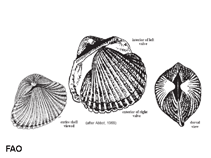Scapharca brasiliana (Lamarck, 1819)
Classification / Names Common names | Synonyms | CoL | ITIS | WoRMS
Bivalvia | Arcida | Arcidae
Environment: milieu / climate zone / depth range / distribution range Ecology
Benthic; depth range 0 - 75 m (Ref. 83435). Tropical; 18°N - 18°N, 88°E - 88°E (Ref. 83435)
Distribution Countries | FAO areas | Ecosystems | Occurrences | Introductions
Western Atlantic.
Length at first maturity / Size / Weight / Age
Maturity: Lm ? range ? - ? cm Max length : 4.1 cm DL male/unsexed; (Ref. 83435); common length : 7.8 cm TL male/unsexed; (Ref. 344)
Short description Morphology
Shell heavy, sturdy, almost as high as long, inequivalve, with left valve overlapping right. Sculpture of 26 to 28 radial ribs of square cross-section, each with prominent beads. Umbones facing each other. Hinge straight, ligament short, ligamental area with transversal striations. Periostracum thin. Colour: white, periostracum light brown (Ref. 344).
It has a total length of 7.8 cm. Fisheries: collected mostly in the southern half of the area (Ref. 344).
Life cycle and mating behavior Maturity | Reproduction | Spawning | Eggs | Fecundity | Larvae
Members of the class Bivalvia are mostly gonochoric, some are protandric hermaphrodites. Life cycle: Embryos develop into free-swimming trocophore larvae, succeeded by the bivalve veliger, resembling a miniature clam.
Main reference
References | Coordinator | Collaborators
Leal, J.H. 2003. (Ref. 344)
IUCN Red List Status (Ref. 130435: Version 2024-1)
CITES status (Ref. 108899)
Not Evaluated
CMS (Ref. 116361)
Not Evaluated
Threat to humans
Harmless
Human uses
| FishSource |
Tools
More information
Trophic Ecology
Ecology
Population dynamics
Growth
Age/Size
Length-weight
Length-length
Length-frequencies
Mass conversion
Recruitment
Abundance
Age/Size
Length-weight
Length-length
Length-frequencies
Mass conversion
Recruitment
Abundance
Life cycle
Distribution
Human Related
Aquaculture profile
Stamps, Coins Misc.
Stamps, Coins Misc.
Outreach
References
Internet sources
BHL | BOLD Systems | CISTI | DiscoverLife | FAO(Publication : search) | Fishipedia | GenBank (genome, nucleotide) | GloBI | Gomexsi | Google Books | Google Scholar | Google | PubMed | Tree of Life | Wikipedia (Go, Search) | Zoological Record
Estimates based on models
Price category
(Ref. 80766):
Unknown.



